Forty thousand lumens!!!




No, it’s not false claims like the 990,000 lumen zoomies you see on sites like Wish. This is the Acebeam X50 that makes use of no less than 8 CREE XHP70.2 LEDs. An individual XHP70.2 is impressive by itself on something like the Convoy M3-C but having 8 of them gives the X50 serious output. The Acebeam X50 is a soda can size flashlight, with more power than many flashlights twice its size.
You can buy the Acebeam X50 from Amazon or directly from Acebeam.

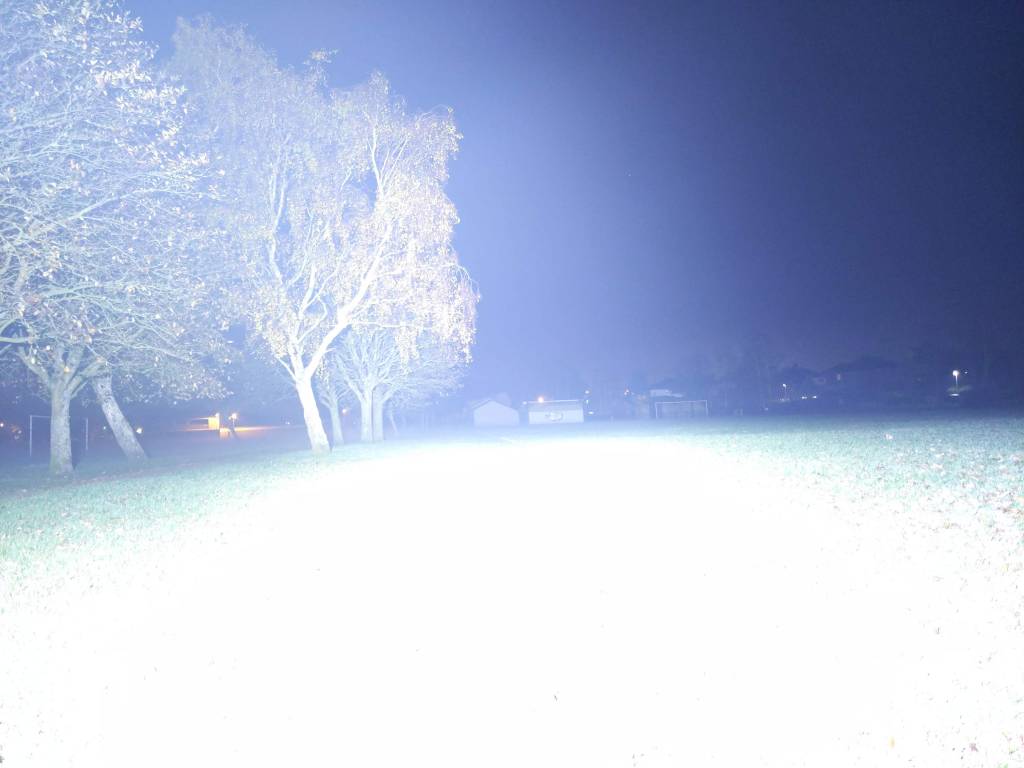

Acebeam are well known for both their high power and long distance flashlights.
The “K” series is their high output and long distance range. I’ve reviewed the Acebeam K30-GT for 1lumen and they also have the incredible Acebeam K75 that throws 2.5km.
Acebeam also have their high output multi-LED “X” series, which I’ve outlined below, some of which are now discontinued:
| Model | Lumens | Throw |
| X10 | 7,000 lumens | 469m |
| X45 | 18,000 lumens | 635m |
| X50 | 40,000 lumens | 800m |
| X65 | 12,000 lumens | 1301m |
| X65 Mini | 12,000 lumens | 1403m |
| X80 | 25,000 lumens | 332m |
| X80-GT | 32,500 lumens | 369m |
| X80-CRI | 4,500 lumens | ? |
| X80-UV | 10,000 lumens | ? |
| X70 | 60,000 lumens | 1115m |
Acebeam is one of the few flashlight manufacturers that offer lights in a choice of warm white or cool white LED. Warm white normally means the output is a small % lower but this is a reasonable sacrifice to get a subjectively much nicer light output.
Acebeam are well known for their high efficiency constant current and voltage drivers. These allow their lights to sustain high output levels over the whole run time.
Specs
| Brand / Model | Acebeam |
| Model | X50 |
| LED | 8 x XHP70.2 |
| Lumens | 40,000 lumens (cool white) or 38,000 lumens (neutral white) |
| Throw | 800m / 160kcd (cool white) or 750m / 141kcd (neutral white) |
| Cells | Built in battery pack (3 x 21700) |
What’s in the box?



Not only do you get a fancy box from Acebeam, you also get all sorts of goodies inside:
- X50 flashlight and battery pack
- Handle and screw
- Mains powered charger
- Holster
- 2 Spare O-rings
- Lanyard
- Manual, warranty card and warning card



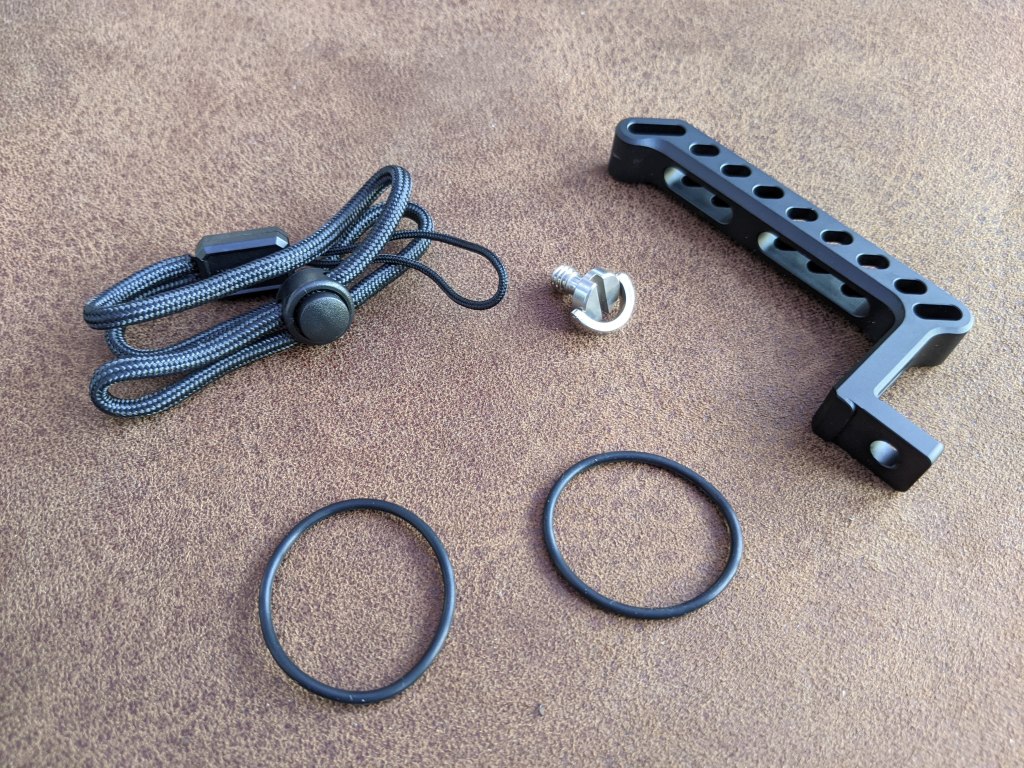
The handle is optional but highly recommended if you use it on high or turbo lots.




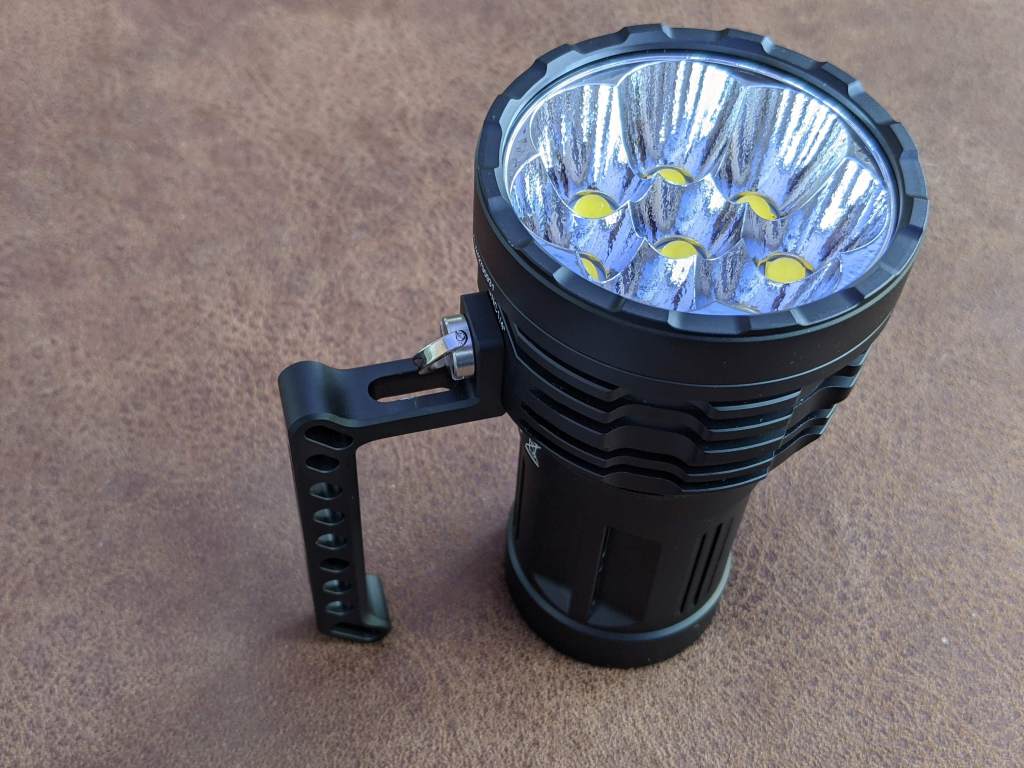
The mains power adaptor I received was a UK one, which was a nice surprise. I assume Acebeam has a few options available.
The USB cable is C-to-C and a very generous 2m long.


Size and everyday use
The X50 is a chunky light but not too big. I have medium size hands and can touch my thumb and index finger together whilst holding it. It’s definitely the biggest “soda can” size light that I own, with a similar size head as the Astrolux MF01S and Imalent R60C. You can hold it just by the body but after a few minutes it feels more natural to have 2 fingers under the head and 2 under the body.

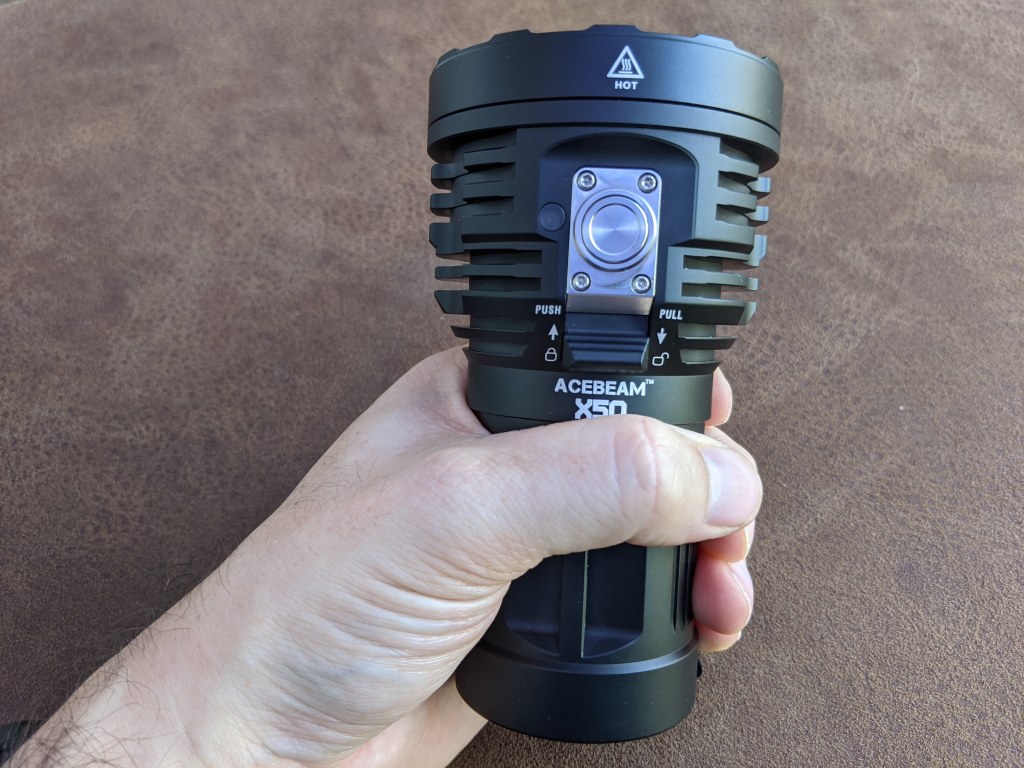



Holding it like this allows your thumb to rest on the main switch. Talking of the switch, it’s all metal and looks very high quality. It’s not mushy but doesn’t “click” in the same way as the K30-GT I have. There’s also a separate lockout switch – more on this later.
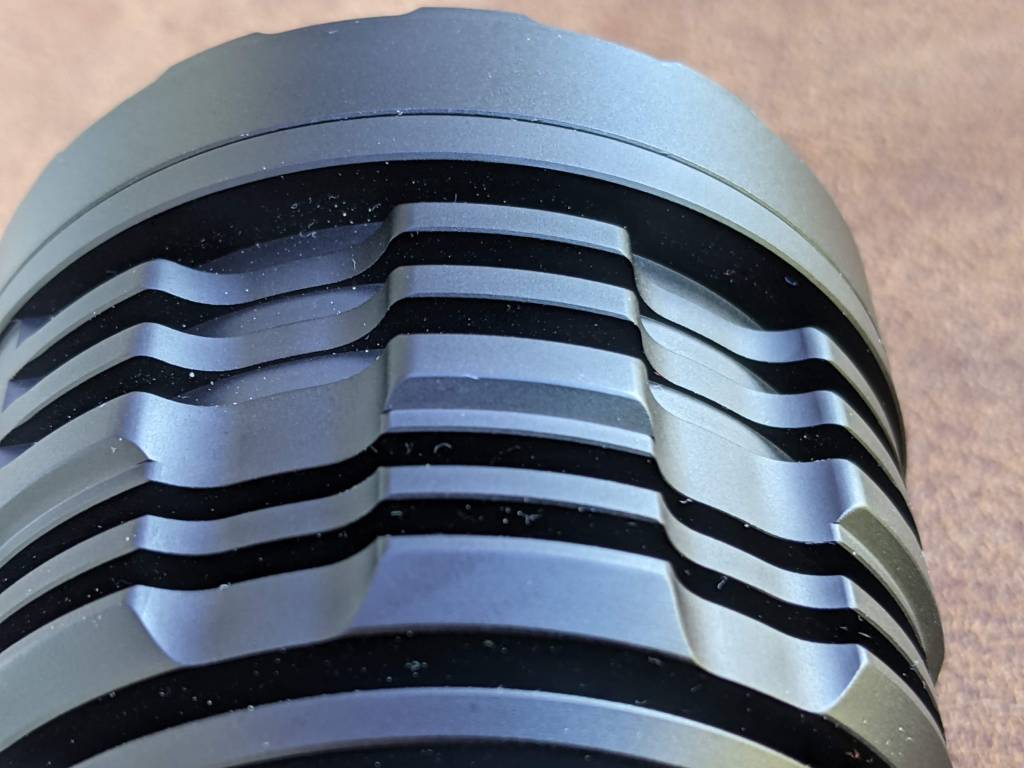

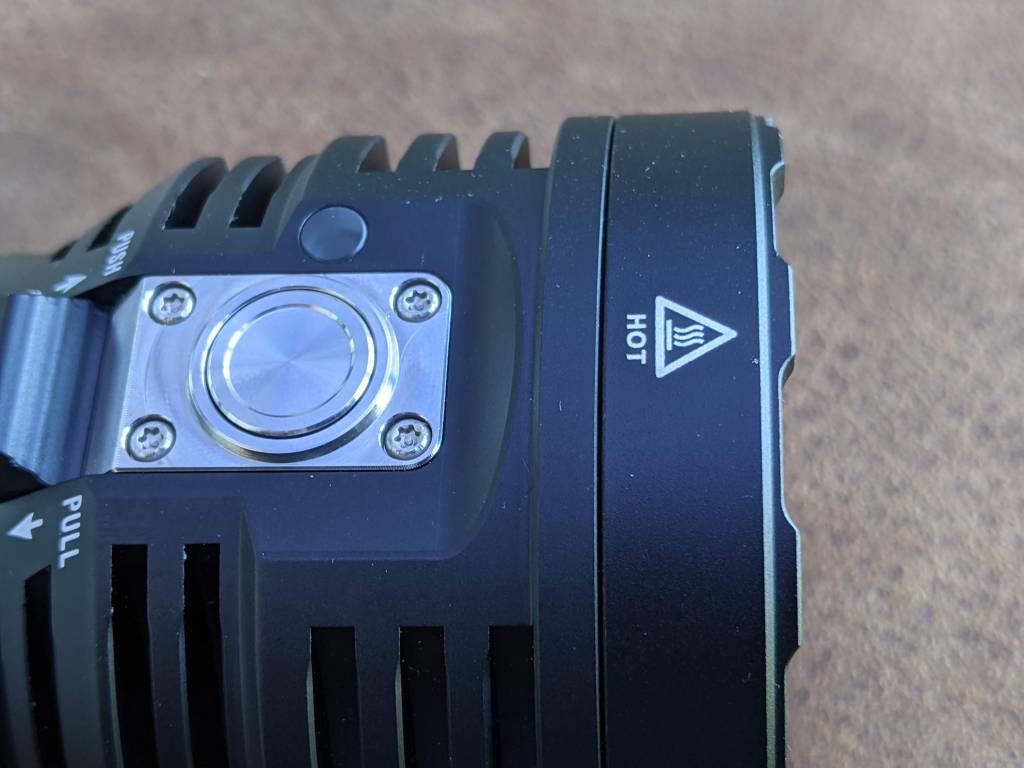
The head has fairly deep fins for heat dissipation, which come in very handy. The main body is slightly unusual in that it has cutouts too. These might look uncomfortable but were fine in everyday use.
Insides
Opening it up, the threads smooth but are quite tight. After a few turns you can see there’s plenty of lube on the threads. The light then splits into 2. The head has a brass coloured connector which can depress about 1mm. Surrounding this is a black foam that I wasn’t brave enough to remove.
The X50 doesn’t look like it’s easy to mod.




LEDs
The Acebeam X50 is powered by no less than eight CREE XHP70.2 emitters. These each receive about 40W of power, producing around 5000 lumens each in the light.


XHP70.2 LEDs can actually be driven to over 8000 lumens (see this post from Texax_Ace) but at this wattage it shortens their life and is about half as efficient. This efficiency is the reason Acebeam have used 8 LEDs instead of 5 with the X50 and means the LEDs operate at around 150 lumens per Watt that they receive.

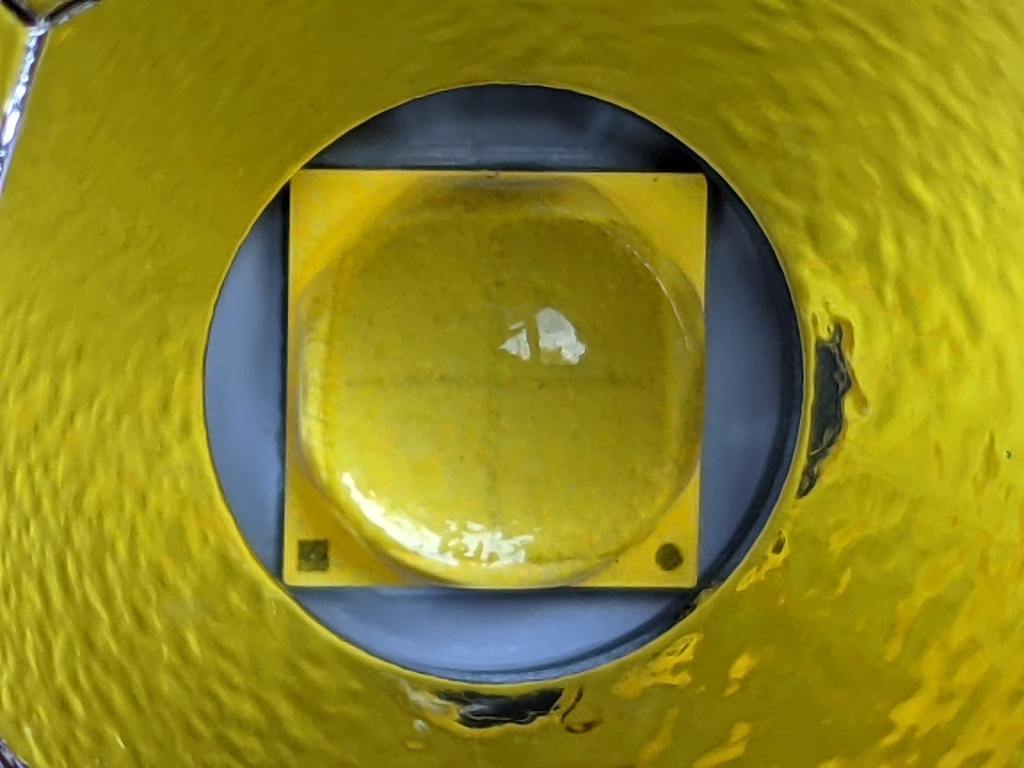
Acebeam offers the X50 in either cool white (6500K) or neutral (5000K). CREE also makes warmer (4000K and 3000K) versions of the LED but Acebeam don’t provide these as an option.



The 8 LEDs sit in a fairly shallow orange peel reflector, with each LEDs parabola merging with its adjacent ones. The big LEDs and short reflector result in a floody beam of 3.7 cd/lm. That’s more floody than the Sofirn SP36 or Emisar D4V2.
Size, weight and comparison
Length:
- Length: 135mm
- Head diameter: 75mm
- Body diameter: 54mm
Weight:
- Without cells: 699g
Acebeam X50 compared to other soda can flashlights
Left to right: Acebeam K30-GT, Acebeam X50, Imalent R60C, Sofirn SP36, Astrolux MF01S

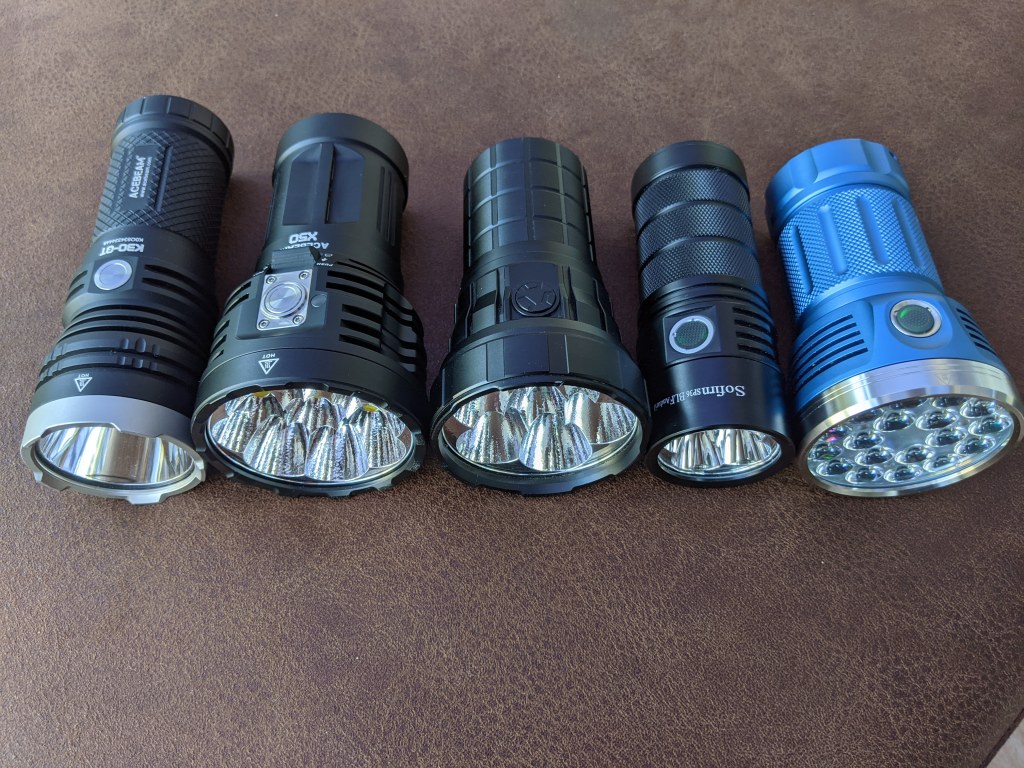

Acebeam X50 vs Imalent R60C

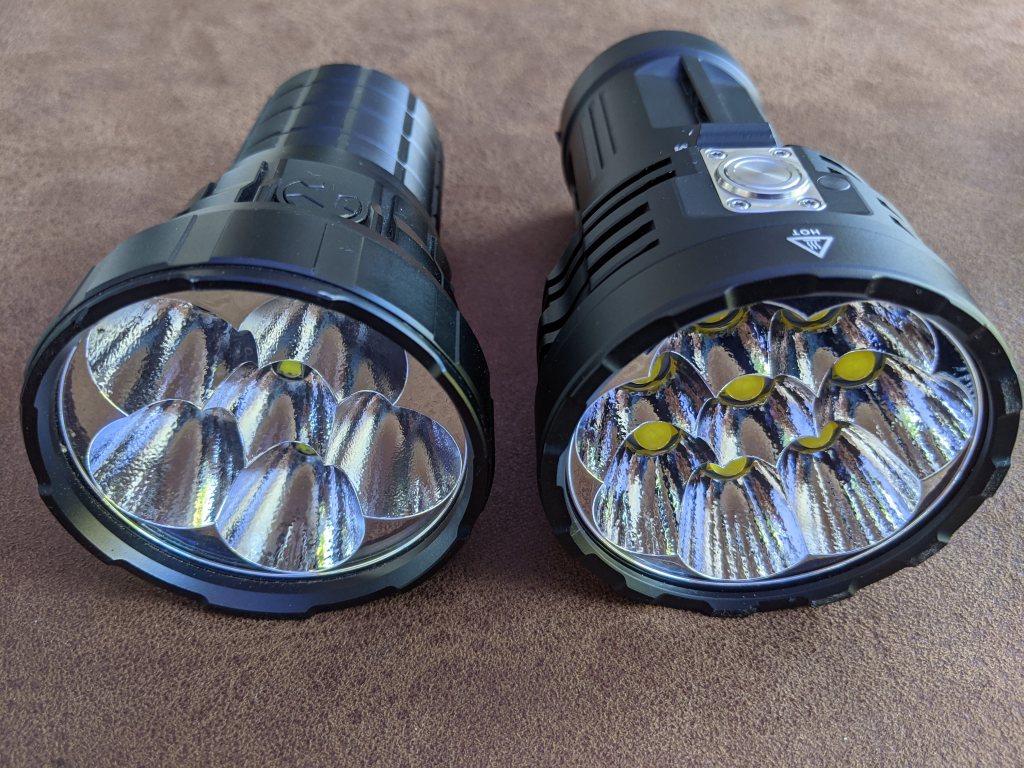

High power flashlight comparison
Left to right: Astrolux MF01S, Nextorch Saint Torch 31, Acebeam X50, Imalent R60C.
The Acebeam X50 is brighter than the massive Nextorch
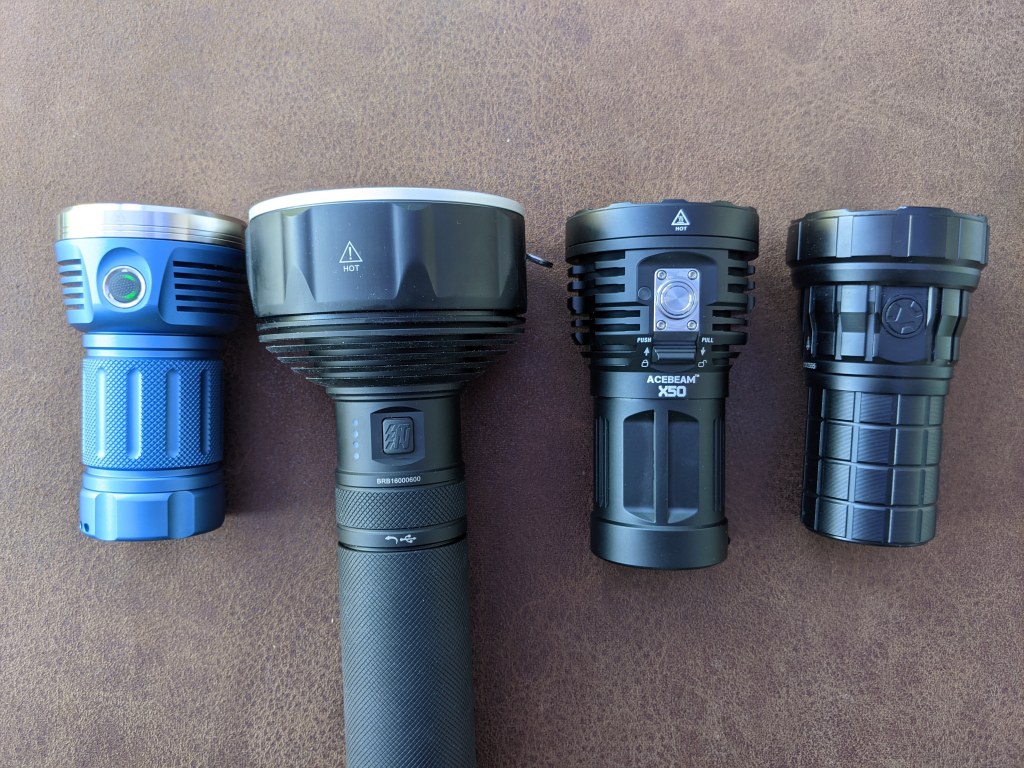

User Interface
Click on, click off, hold to change brightness.
The X50 uses Acebeam’s standard UI. When on, holding the switch cycles upwards through Low, Med1, Med2, Med3, High, then loops back to Low. Holding while off goes to ultra low and won’t change brightness unless you first let go of the switch. This means you can only get to ultra low from off.
The light has mode memory on all modes aside from ultra low and turbo.
Oh, “ultra low” by Acebeam’s standards is still 230 lumens. An old incandescent 6D Maglite is 178 lumens. Yes, you read that right. The lowest mode on this Acebeam is still brighter than the brightest you could get from Maglite just a few years ago.
Double clicking from any mode – on or off – always goes to turbo. Doble click from turbo goes back to the memorized mode.
Triple click activates strobe. Argh, my eyes!



What sets the X50 apart from other Acebeam lights is the lockout switch. This switch is a paddle you can push up or down with a satisfying click, taking a fair bit of force. When pushed up the e-switch is physically disabled. It seems like the lockout switch moves something between the e-switch button and the switch itself. This means that you can lock the light on as well as locking it off!
Whenever the light is on then you’ll see the battery indicator light next to the e-switch. This is green when the battery is over 30%. It turns red when the battery is low (under 30%) and flashes red when nearly empty (under 10%). As the battery drains, the light will keep stepping down brightness and eventually turn off.
Battery pack
The body part contains the cells and charging circuit. The inside is held together with 3 security torx screws that are made even more tamper-resistant with some glue. On the outside of the battery pack there’s a big warning label and 4 more glued down torx screws. Acebeam really doesn’t want you replacing the cells in here! You can buy a new battery pack from Acebeam but this costs significantly more than 3 of their cells. I can see why Acebeam has gone down this route – perhaps it’s best for most consumers – but as an enthusiast I’d prefer to be able to replace the cells more easily. Fortunately li-ion cells last a long time these days and you’re likely to get years of use out of the light.

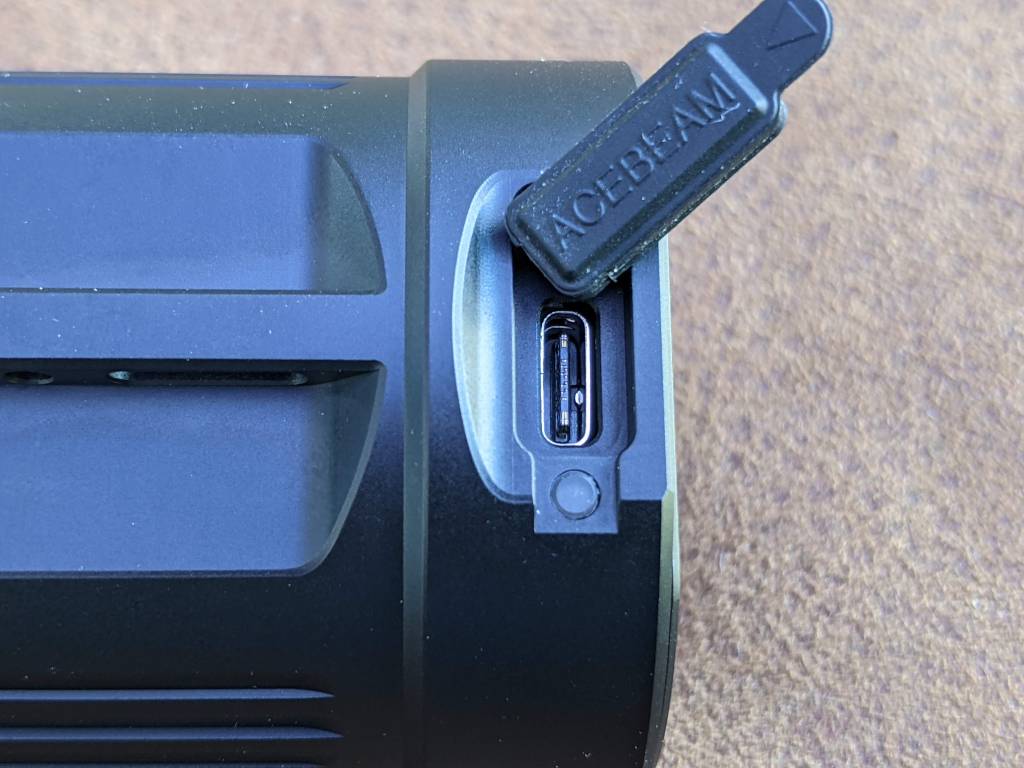

Acebeam lists the battery as 10.8V/4250mAh, so if you could get inside, you’d see three high drain 21700 cells.
Charging
At the bottom of the battery pack there’s a rubber port cover. Pulling this reveals a USB-C port for charging or power bank functionality.
The manual says the light takes 1.8 hours to fully charge or 1.5 for 90%. Unfortunately the light didn’t want to draw any power when I put a USB meter inline. Still, it’s great to see fast charging on the light.
When charging, there’s a small red light next to the USB-C socket that stays on when it’s receiving power.
The battery charges up to 12.44V, which is a healthy 4.15V per cell.


You should be able to use any USB charger but the one Acebeam provides has a USB-C socket and works with the provided 2m USB-C cable. The power brick says it provides a wide range of PD outputs: 20V@3.25A, 15V@3A, 12V@3A, 9V@3A, 5V@3A. My USB meter shows QC2 @ 12V but keeps resetting when trying to check the PD output.
Power bank
As well as charging over USB-C, you can also use the X50 as a power bank. In fact you can unscrew the head and just use the battery pack as a USB power bank if you want.
When providing power the same red light is on next to the USB-C port. This means that if you plug the X50 into another power bank then you can’t tell what’s charging what.
Acebeam states the light will provide QC3 & PD3 output. My USB meter said yes to QC2 all the way up to 20V but no to QC3. It also seemed happy with USB-PD too, as was my phone, which showed “charging rapidly”. The flashlight also powers my Dell XPS laptop fine.
Performance
Note that this is the 5000K version. The 6500K version should give slightly higher numbers.
Lumen and throw measurements
All lumen measurements are from my home made integrating sphere, calibrated with a S2+ measured by Maukka. Measurements are done with a UNI-T UT383S lux meter and Adafruit TSL2591 connected to a Raspberry Pi (using RuTiTe by bmengineer). Expect them to be within +/-10%.
Note: this is the brightest light I’ve measured, so take these numbers with a grain of salt.
| Mode | Lumens (spec) | Measured lumens (0s) |
| Ultra low | 200 | 175 |
| Low | 600 | 594 |
| Med 1 | 2,150 | 2,049 |
| Med 2 | 6,200 | 5,926 |
| Med 3 | 13,500 | 13,326 |
| High | 24,000 | 24,014 |
| Turbo | 38,000 | 32,478 |
Throw
Throw was measured at 10m. Like a few other reviewers, my numbers for the 5000K X50 were a bit lower than Acebeam’s specs. Whilst this isn’t great, by eye you’re unlikely to notice much difference between 600m throw and 750m throw.
| Mode | Spec (m) | Spec (cd) | Measured throw (m @ 0s) | Measured intensity (cd @ 0s) |
| Ultra low | – | – | 78m | 1526 cd |
| Low | 110m | 3,025 cd | 106m | 2,816 cd |
| Med 1 | 230m | 13,225 cd | 172m | 7,393 cd |
| Med 2 | 330m | 27,225 cd | 281m | 19,715 cd |
| Med 3 | 460m | 52,900 cd | 411m | 42,305 cd |
| High | 600m | 90,000 cd | 551m | 75,868 cd |
| Turbo | 750m | 140,625 cd | 638m | 101,743 cd |
Runtime
Each time the battery was charged until full, around 12.4V. After the light steps down, it eventually turns off due to the low voltage protection. The battery pack then measures 0V but with a few seconds on a charger to reset the circuit it’s at 9.21V (3.07V per cell, which is good).
Run times will depend on ambient temperature, as the X50 will drop down if it gets above 65°C. As these tests were taken indoors, you should get better results outside.
The light sustains its massive turbo output for a minute before dropping down to around 4600 lumens, which it sustains for an hour.
High is similar, lasting over 90 seconds above 22,000 lumens, then stepping down like turbo does.
Med3 lasts 4 minutes above 12,500 lumens, then steps down.
Med2 lasts 18 minutes at 5600 lumens, then steps down.
Med1 doesn’t step down at all and lasted 3h20m at 2000 lumens.



| Mode | Spec | Run time to 10% |
| Ultra low | 24h | – |
| Low | 11h | – |
| Med 1 | 3h40h | 3h20m |
| Med 2 | 2h | 1h25m |
| Med 3 | 1h50m | 1h18m |
| High | 1h45m | 1h08m |
| Turbo | 1h30m | 1h02m |
What I liked
- Loads of light output – my brightest light by far
- Still reasonably sized
- Amazing driver regulation: sustains almost 5000 lumens for an hour
- Choice of LED
- USB-C that has QC and PD power bank feature
- Simple UI with physical lock out
- General quality is top notch
What could be improved
Aside from squeezing more power from the cells and LED, there’s not much Acebeam could do with this light.
If I designed it then I’d make the cells replaceable but I don’t blame Acebeam for making the X50 use a battery pack here as it makes it accessible to a wider market. I’d also probably put very warm 3000K LEDs in but that would result in much lower output.
The battery level indicator could be improved as there’s no difference between 31% full and 100% full. Ideally I’d like to know when the light drops below 70% or so, as then I may want to top it up.
Along the same lines, it would also be handy to know whether the battery was acting as a power bank or charging. At the moment these both result in a red LED.
Conclusion


It’s just so bright! I’m very impressed by the X50.
I love Acebeam lights and I find it a challenge to find faults with them. While my X50 didn’t quite hit Acebeam’s specs, it was close and the end result is still incredible from a soda can size flashlight.
Remember how just a few years ago we were amazed by 4000 lumen lights like the Nitecore TM26? Well, just 8 years later the Acebeam X50 is the same size and about 10 times brighter. The Acebeam X50 is like the Acebeam X80-GT but with a more useful beam and better features.
You can buy the Acebeam X50 from Amazon or directly from Acebeam.

Great write up! What do you think of the new 4000K, 95 CRI option? Not sure myself between this and the 5000K version. Thanks!
LikeLike
I like the idea of the 4000K one. I think it has FC40 LEDs, which are known to be good.
The CREE version is brighter but 20,000 lumens is still impressive and you might not notice much difference in output.
https://www.acebeam.com/x50-photographic-lighting
LikeLike
Thanks! I haven’t had a 4000K flashlight before. This could be the first!
LikeLike
its funny you boast about the x50 having 8 x xhp70.2 cree led lights.
buy in the SPECS box you posted about the x50 flashlight. It says 8 x xhp50.2 led lights.
So im not quite sure you are advertising the correct light. Maybe its the x70 that has the xhp70.2 . which would make sense.
I always check the fine print.just like you gotta check all those Chinese sellers now on Amazon boasting. saying it is this big, but when you get its never is.
LikeLike
Thanks for spotting this! Looks like I put the specs in wrong. I’ve updated it now. They’re definitely XHP70.2 LEDs as they’re 7mm in diameter. The XHP50.2 are 5mm and noticeably smaller.
You can never tell with most Amazon listings. There are so many cheap flashlights claiming a million lumens. Acebeam are definitely one of the good ones though.
LikeLike